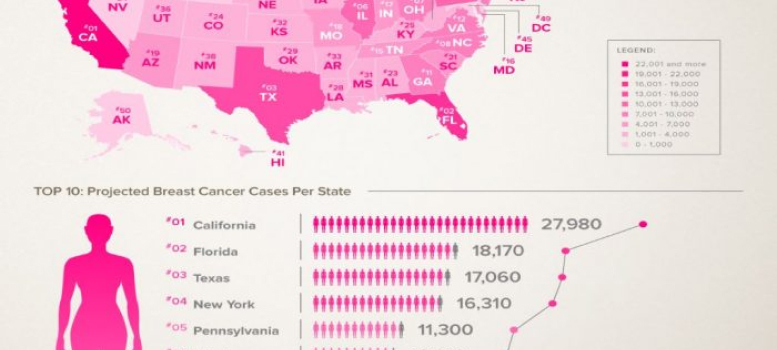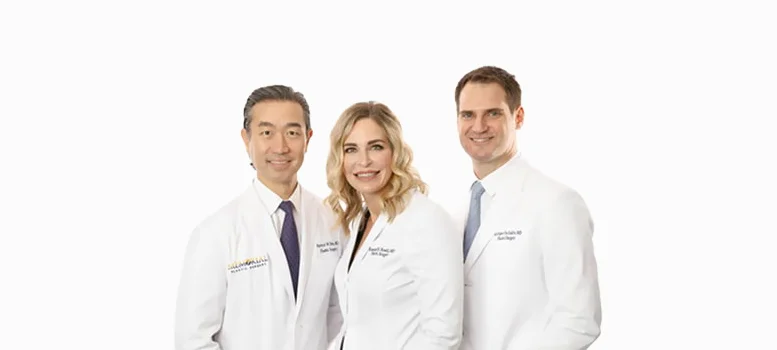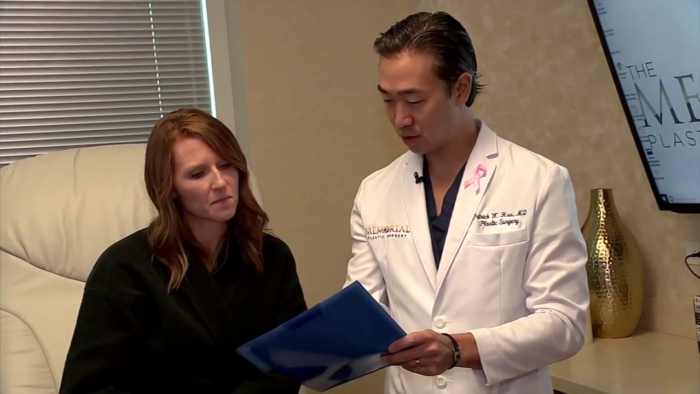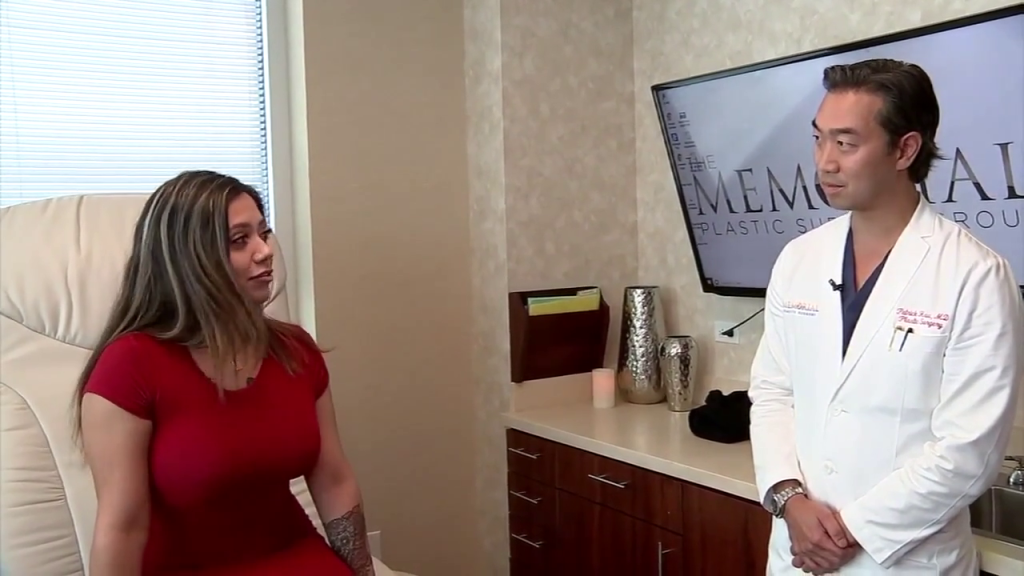Since 1951, the annual Cancer Facts & Figures report has provided the public with an informative and easy to read resource about cancer and all its forms. Inspired by the spirit of Women’s Month, the board-certified plastic surgeons at Memorial Plastic Surgery have compiled these figures in order to educate the public on the growing problem of breast cancer.
Every day, thousands of brave women struggle to stay alive in their fight against breast cancer. This often comes at the expense of an incredible sacrifice that will change their bodies forever. While cancer can be treated through surgery and therapy, continued awareness can play a crucial role in decreasing the projected number of annual deaths.
2017 Breast Cancer Statistics
According to the most recent data provided by the American Cancer Society, 252,720 women in the United States are expected to develop breast cancer in 2017. This marks an annual growth rate of 2.40%. Similar to previous years, the most populated US states are predicted to have the most number of breast cancer cases this year. California (27,980) ranks number one and is expected to have an astounding 50% more breast cancer cases than the second-highest ranked the state of Florida (18,170).

However, when the cases per state are divided by its female population, the per capita figures reveal that women in one of the country’s smallest states are the most susceptible to developing the disease. The American Cancer Society predicts that 1 out of every 502 women in Maine will be diagnosed with breast cancer this year. Florida and New Hampshire follow closely tied at second with 1 in 529 expected cases.
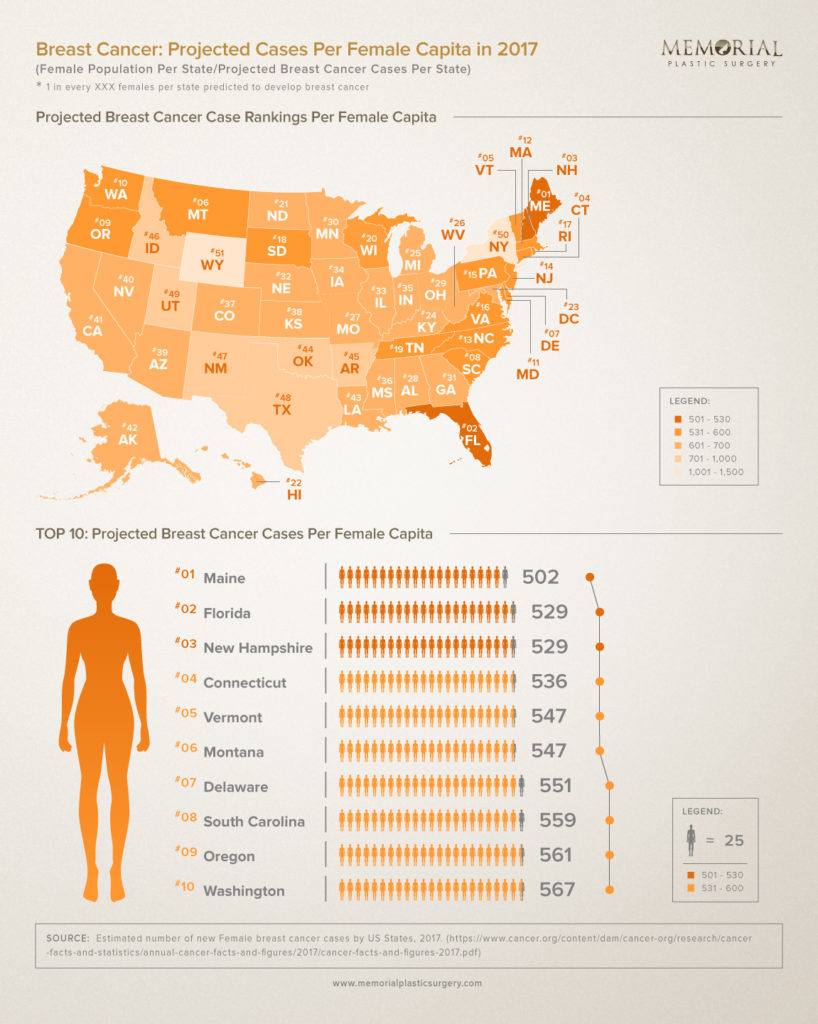
Mortality
Out of the thousands predicted to develop breast cancer this year, 40,590 women are expected to die, with the largest states seeing the largest number of potential deaths:
- California: 4,440 estimated deaths
- Florida: 2,910 estimated deaths
- Texas: 2,830 estimated deaths
- New York: 2,410 estimated deaths

While California will see the biggest losses from breast cancer in 2017, the death numbers, once again, show a different story when compared to each state’s current female population. When the predicted deaths are divided by the predicted breast cases per state, the numbers reveal that women diagnosed with breast cancer in Arkansas, Oklahoma, DC, and Nevada are most at risk:
- Arkansas: 20.00% projected mortality rate
- Oklahoma: 19.70% projected mortality rate
- District of Columbia: 19.23% projected mortality rate
- Nevada: 18.91% projected mortality rate
“It is worth noting that states such as Arkansas and Nevada have a high ratio of rural communities, perhaps making regular checkups and treatment difficult, compared to more densely populated states such as California and New York”, speculates Dr. Patrick Hsu, founder and CEO of Memorial Plastic Surgery. “Washington DC ranks 3rd but sits as a bit of an outliner because its sample size is so small with less than 600 predicted breast cancer cases in 2017.”
Breast Cancer Screening and Prevention
There are a number of variables that cause breast cancer, with genetics being a major component. This is not to say that genetics is simply the root cause of breast cancer. As numerous studies have shown in the past, variables such as age, lifestyle, and medical history can play a significant role in the development of breast cancer.
The technology around breast cancer has improved, with techniques in pre-emptive care that allow women to take action at the first sign of any irregularities.
This starts by regularly undergoing routine mammograms. Yearly check-ups are recommended, as the Mayo Clinic found a decrease in breast cancer deaths of up to 29% through mammogram screenings alone.
“Undergoing regular mammogram screenings can really go a long way”, says Dr. Kendall Roehl, Head Plastic & Reconstructive Surgeon at Memorial Plastic Surgery’s Clear Lake, TX office. “Mammograms allow for early detections of abnormalities and cysts, and also provide women with a thorough medical history that can be incredibly valuable as they age.”
While the use of ultrasound imaging has been used to complement mammograms, they have proven to be just as effective on their own. A study published in the Journal of the National Cancer Institute in 2015 found that screenings that involved ultrasound produced results comparable to mammograms. While it’s not a replacement for screenings, it is a viable alternative in cases when mammogram screenings are not possible.
Another means of screening is through a breast biopsy. This slightly invasive procedure extracts tissue from the breast that will later be examined in order to diagnose the presence of breast cancer in the body.
Pre-Emptive Care For Breast Cancer Patients
Among such plans that have become increasingly prominent in recent years is a Prophylactic Mastectomy. More commonly known as a Pre-Emptive Mastectomy, this procedure involves the removal of the breasts in order to reduce the risk of developing breast cancer.
Angelina Jolie brought the procedure into the public light in 2013, when she underwent a pre-emptive double mastectomy having discovered an 87% risk of developing breast cancer due to a mutated BRCA gene. According to the Center for Disease Control and Prevention, only 3 in 100 breast cancer patients have the BRCA1 or BRCA2 mutation.
“While a pre-emptive mastectomy can greatly reduce the chances of developing breast cancer, it is still a procedure that needs to be weighed in by the patient and her team of specialists”, says Dr. Roehl. “Regardless of what the patient chooses, we always recommend that she, if possible, undergo testing for the BRCA mutation gene.”
It is a sentiment shared by Dr. Patrick Hsu. “Ultimately, it’s up to the patient to decide what course of action is best for her. However, with that said, due to the advances in breast reconstruction techniques, pre-emptive mastectomies are becoming more popular. For example, procedures such as DIEP Flap and Nipple Sparring Mastectomy, use skin, tissue, and fat from other parts of the body allowing for results that look and feel natural.”
Steps To Take If Diagnosed With Breast Cancer
In the event breast cancer is detected, doctors advise patients to seek multiple opinions. A second and third round of opinions is one of the most important things a patient can do. Multiple opinions can confirm the initial diagnosis and provide more details about the stage and type of breast cancer. Additionally, they also provide alternative recovery plans that can either be considered or combined with an existing one.
“Always seek a second opinion”, advises Dr. Hsu. “It is important to consult not only a breast surgeon but also a board-certified plastic surgeon who specializes in breast reconstruction. This provides women with the chance to completely explore their options.”
If breast cancer is detected, it is important to think positively. The best thing anyone can do is to start by doing the proper research: read any available literature, find the right doctor, and have multiple rounds of opinions. Online communities are an incredible resource for breast cancer survivors and are always available to share their experiences with women who are just about to begin the journey. Below are some amazing websites to start with:
American Cancer Society: https://www.cancer.org/
Breast Cancer Texas: https://www.breastcancertexas.com
Susan G. Komen for the Cure: www.komen.org
Without a doubt, the breasts are the single, most defining feature of a woman’s body. It is so closely tied to femininity and personal identity that the greatest emotional trauma for many breast cancer survivors comes from the loss of their breasts.
Thankfully, advancements in the world of reconstructive surgery have enabled many breast cancer survivors to feel whole again. Breast surgeons together with plastic reconstructive surgeons across the country have dedicated their entire careers to helping women restore their bodies. By allowing breast cancer survivors to feel complete again, these specialists are now equipped with the experience and insight to provide women with natural, surgically reconstructed breasts.
The data presented here is alarming, but with awareness and regular screenings, steps can be made to ensure that the number of deaths decreases in time.


